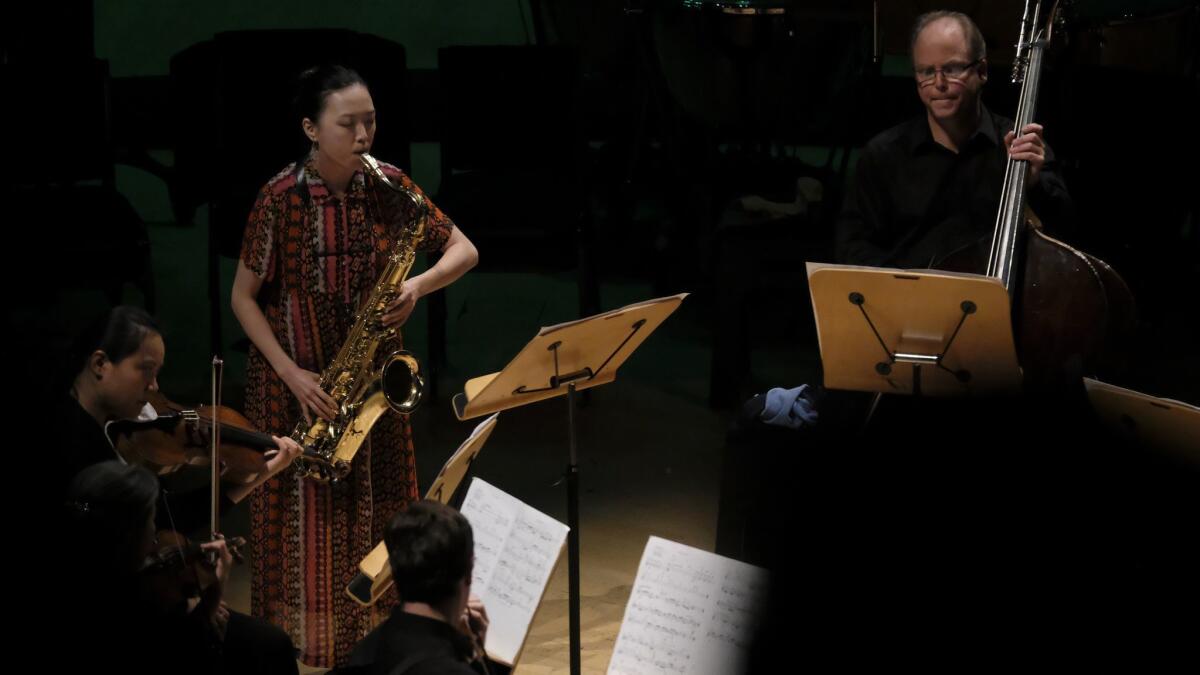Review: Edgy jazz crosses over to classical, or is it the other way around?

- Share via
The cultural and musical divide between jazz and classical music has always been overrated. Freedom of improvisation versus the deliberation of notation, commercial considerations, acquisition of technique, even the whole notion of connoisseurship and classicism have always been two sides of a shared coin.
This is true within the traditional wings of the genres, given that for far more than a century, classical composers have drawn considerable inspiration from jazz, and jazz musicians have typically been classically trained. But it is even more true along the progressive edges, which is where the Los Angeles Philharmonic hung out Tuesday night in a Green Umbrella program at Walt Disney Concert Hall curated by Herbie Hancock, the creative chair for jazz. The very fact that the L.A. Phil has maintained a longtime creative chair for jazz should tell you something.
Enthusiastically and idiomatically led by the orchestra’s assistant conductor, Paolo Bortolameolli, the L.A Phil New Music Group premiered six works it commissioned from jazz musicians on the cutting edge of a vibrant scene that negates any talk about jazz being a dying enterprise.
Yet for all that, bridging the gap proved a little uncertain. It was not that the musicians spoke languages that were inappropriate musically and intellectually for a new music program. The hall was just about full with an eager and sophisticated audience. Jazz is, and has been at least since Gershwin’s day, at home at the L.A. Phil. But in a way that was a little hard to put one’s finger on, something felt a little off.
Perhaps it was the fact that neither Hancock, who was said to be occupied recording in the studio, nor three of the six composers were present. Although all the composers happen to be stellar players, only two write works that included themselves. Mostly, though, it was a nervous conservativism that characterized much of the music. Little if anything here would have been startling half a century ago.
The two composers who did write for themselves were saxophonist Hitomi Oba and pianist Billy Childs. Both are highly visible and remarkably versatile L.A. musicians with a penchant for crossing all over the musical place.
Oba’s “Aina” is a short piece for her, string quartet and bass in which her own powerfully inventive improvisation seemed to float over a pond of sedately modernists strings. Employing a chamber orchestra, Child’s “Of Darkness and Light” turned out to be a small piano concerto that began with power chords and the ominous feel of Bernstein’s “The Age of Anxiety.”
It soon brightened up, but in this case the ominousness didn’t disperse as quickly as it was supposed to. After a couple of minutes, a theremin-like wail took it to unexpected places. Someone had set off a fire alarm in the parking lot, and the performance had to be stopped until the alarm could be disarmed and the piece begun again. As fate would have it, the interruption added a sense of resolve to Child’s commanding solos. Too bad he can’t write the alarm into the score.
Two jazz musicians — both MacArthur fellows — who are prominently rewriting the jazz playbook did not rewrite the jazz playbook here. Vijay Iyer’s “Crisis Modes” for a mixed chamber ensemble has roots in Asian and Western music and includes an orchestration in the middle of a piano improvisation. The ideas are engaging, but the effort to make everything congeal lessened their individuality. More interesting would have been an actual Iyer improvisation in the middle.
Tyshawn Sorey’s “For Fred Lerdahl,” a tribute to one of his Columbia University professors, is a finely wrought short work for piano, viola and percussion that quietly shimmers like early Morton Feldman. A brilliant drummer and a composer known for extravagance, Sorey seemed to be watching his step, his old teacher still looking over his shoulder.
The ecstatic saxophonist Kamasi Washington didn’t exactly watch his step in “Struggle From Within,” not with his big tunes from booming brass and winds or his rich string accompaniments. Hindemith sometimes came to mind. But Washington also ultimately came across as cowed by the occasion, ending oddly with a Dvorák-like sweet tune first for flute, with two cellos offering simple accompaniment growing into a concluding climax. He could, should and probably will take this much further with his own ensemble.
The outlier was Hermeto Pascoal. The 81-year-old Brazilian jazz legend turned to his group’s pianist, Jovino Santos Neto, to orchestrate a piece that Pascoal’s band had originally played three decades ago. With Neto as soloist and with a brightly textured chamber ensemble, “Suite Universal” became a suite universe, its Brazilian tunes zapped by oddball accompaniments and the pianist’s distinctive improvisations coming from left field or maybe Mars. If not exactly new, the Pascoal-Neto suite did manage to cross a particularly vast divide.
More to Read
The biggest entertainment stories
Get our big stories about Hollywood, film, television, music, arts, culture and more right in your inbox as soon as they publish.
You may occasionally receive promotional content from the Los Angeles Times.











